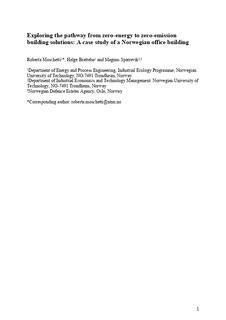| dc.contributor.author | Moschetti, Roberta | |
| dc.contributor.author | Brattebø, Helge | |
| dc.contributor.author | Sparrevik, Magnus | |
| dc.date.accessioned | 2019-04-10T13:45:16Z | |
| dc.date.available | 2019-04-10T13:45:16Z | |
| dc.date.created | 2019-02-05T08:36:15Z | |
| dc.date.issued | 2019 | |
| dc.identifier.issn | 0378-7788 | |
| dc.identifier.uri | http://hdl.handle.net/11250/2594087 | |
| dc.description.abstract | This paper explores the most influential aspects regarding the environmental and economic performance of zero-energy and zero-emission buildings and proposes a pathway for transition in building solutions. A representative zero-energy office building in Norway is investigated with alternative design solutions to achieve zero-emission status i.e., the extensive use of locally generated energy through photovoltaic (PV) panels and the use of materials with low embodied emissions, such as low-carbon concrete and wood. A life cycle environmental and economic assessment is performed to evaluate specific indicators during the building life cycle: cumulative energy (CED), global warming potential (GWP), and equivalent annual cost (EAC).
The extensive use of PV panels was most effective in lowering the operational energy because it reduced the CED by about 30% compared to the building as-built. However, the extensive use of wood in the construction contributed the most to GWP reduction, with around 30% decrease compared to the building as-built. Finally, the differences in EAC were interestingly insignificant among the alternatives, with the investment costs dominating the EAC for all designs examined.
The findings of this paper emphasise that a full compensation of the life cycle GHG emissions from materials is difficult to achieve through renewable energy, even with extensive use of PV panels, especially in a low-carbon grid situation as in Norway. A pathway strategy from zero-energy towards zero-emission buildings must therefore strongly focus on the materials’ embodied energy and emissions because low operational energy demand is already a regulatory priority in most countries. | nb_NO |
| dc.language.iso | eng | nb_NO |
| dc.publisher | Elsevier | nb_NO |
| dc.rights | Attribution-NonCommercial-NoDerivatives 4.0 Internasjonal | * |
| dc.rights.uri | http://creativecommons.org/licenses/by-nc-nd/4.0/deed.no | * |
| dc.title | Exploring the pathway from zero-energy to zero-emission building solutions: A case study of a Norwegian ofÞce building | nb_NO |
| dc.type | Journal article | nb_NO |
| dc.type | Peer reviewed | nb_NO |
| dc.description.version | acceptedVersion | nb_NO |
| dc.source.journal | Energy and Buildings | nb_NO |
| dc.identifier.doi | https://doi.org/10.1016/j.enbuild.2019.01.047 | |
| dc.identifier.cristin | 1673355 | |
| dc.description.localcode | © 2019. This is the authors’ accepted and refereed manuscript to the article. Locked until 4.2.2021 due to copyright restrictions. This manuscript version is made available under the CC-BY-NC-ND 4.0 license http://creativecommons.org/licenses/by-nc-nd/4.0/ | nb_NO |
| cristin.unitcode | 194,64,25,0 | |
| cristin.unitcode | 194,60,25,0 | |
| cristin.unitname | Institutt for energi- og prosessteknikk | |
| cristin.unitname | Institutt for industriell økonomi og teknologiledelse | |
| cristin.ispublished | false | |
| cristin.fulltext | postprint | |
| cristin.qualitycode | 2 | |

